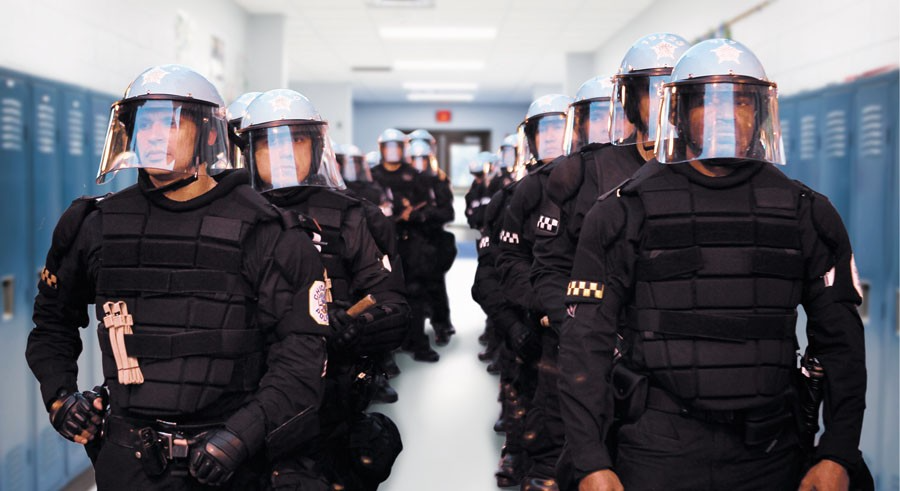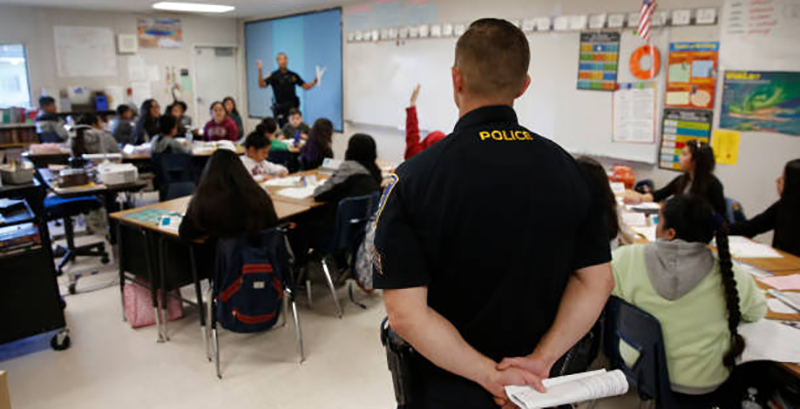This blog post was originally published on Movimiento Poder’s blog and was re-published here with their permission.
By Anahi Quezada-Villa
School resource officers (SROs) are supposed to keep students safe. However, the rise of SROs in schools has not made schools safer. It’s no surprise: Research has continuously shown that SROs have no positive impact on student safety and create school environments that are not safe, nurturing, or equitable. Making matters worse, SROs come at a great unseen cost to students. By continuing to criminalize students, Denver Public Schools are underinvesting in what students actually need to thrive — and disproportionately harming students of color.
Police in schools have increased rates of suspensions and arrests among students. Racial disparities in these trends are apparent — BIPOC (Black, Indigenous, and people of color) students are more likely to be suspended, expelled, and arrested in school than their white counterparts. Consequently, BIPOC students are criminalized for normal, age-appropriate behavior like skipping class, using their cellphone, or dress code violations. In the wake of the George Floyd protests of 2020, Denver Public Schools passed a historic resolution to remove police from schools. The district recognized the damage BIPOC students were facing by having police in schools; however, the district never implemented the 2020 resolution and has instead opted to continue funding the criminalization and surveillance of Denver students.

While the popular belief is that SROs are meant to maintain order and safety in schools, students’ experiences show otherwise. SROs tend to be increasingly involved in routine school discipline matters that could be otherwise handled with a visit to the counselor’s office or de-escalated by a trained restorative justice practitioner. It is evident that police presence in schools does not guarantee school safety but creates unhealthy and inequitable school environments with long-term consequences for students.
Based on data from the 2018-2019 school year, Denver Public Schools reported 657 law enforcement referrals, 25% of which involved Black students, while only 13% of students in Denver identify as Black. Disparities are also apparent in arrests: Black and Latine students were more likely to be arrested than white students. This speaks to the more significant, systemic problem at play — BIPOC youth are disproportionately targeted in their schools in discipline practices. At the same time, their white counterparts get treated much less harshly.
Police presence and zero-tolerance policies have created structural inequities that have, in turn, led to an increase in youth arrests and fueled the school-to-prison pipeline (a term referring to the policies and systems that push youth of color into the juvenile justice system and bar them from opportunities to succeed and thrive). A study of Washington, D.C. schools found that despite comprising only 15% of the student body in schools, Black students made up 36% of arrests in the 2015-2016 school year, consistent with DPS’ pattern of criminalizing young people of color for age-appropriate behavior. Criminalization leads to students getting pushed out of their schools and into the criminal justice system, leaving them with limited opportunities to succeed educationally and professionally after their records have been tarnished. Undocumented youth also face detrimental consequences as policing in their schools increases their risk of being detained or deported and getting one of their family members deported due to police interactions. For undocumented youth, policing and surveillance in their schools and communities means family separation, trauma, mental health impacts, and economic or educational losses.
Criminalization leads to students getting pushed out of their schools and into the criminal justice system, leaving them with limited opportunities to succeed educationally and professionally after their records have been tarnished.

What does police presence in schools mean for students beyond the school-to-prison pipeline? Prioritizing police in schools often means that funding for after-school activities, sports, art, mental health resources, etc., which are necessary for student success, get left out of the picture, leaving our students under-resourced and unsupported. Research shows that one in four students attends schools with an SRO but no counselor, nurse, school psychologist, or social worker. Just one arrest can impact a student’s entire life, blocking educational opportunities and hindering their ability to find employment.
The criminalization of youth in school has been increasingly linked to risks in educational achievement, adult criminal justice system involvement, and recidivism. Studies have demonstrated that arresting a student significantly reduces the likelihood that they will graduate from high school. Furthermore, criminalization also reduces the opportunities for youth to further their academic achievement and develop stable employment. Even worse, criminalization in adolescence can lead to future involvement in the criminal justice system and recidivism in adulthood. Educational environments are meant to foster and nurture the success of youth; however, policing and surveillance are putting at risk the future and livelihoods of students.

Do police create safe school environments?
The data is clear that police in schools create unsafe environments and criminalization of BIPOC youth. Furthermore, police in schools do not get trained on racial equity, restorative justice or have the necessary training for dealing with youth. What having police in schools does is make school environments less safe, with students of color feeling unwelcome, anxious, and distrustful of the adults in their schools. In addition, police in schools create unnecessary trauma for students of color who have to deal with negative interactions with law enforcement in both school and their communities. Several viral videos of police officers committing violence and assaults on students of color on social media have shown the reality of police presence in schools.
The data and students’ experiences paint a clear picture: Police do not make schools safer. They create unsafe and inequitable school environments for all students, especially students of color, LGBTQ+ students, and students with disabilities. The work now is to implement alternatives to policing and the criminal justice system so that students can maintain their educational opportunities, ties to friends and family, and have healthy adult lives.
Keep an eye out for our next blog, where we will discuss the alternatives to school policing and how the best and most successful schools don’t even have police but the proper resources their students need to succeed.
